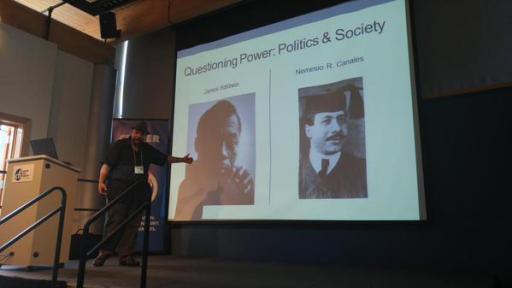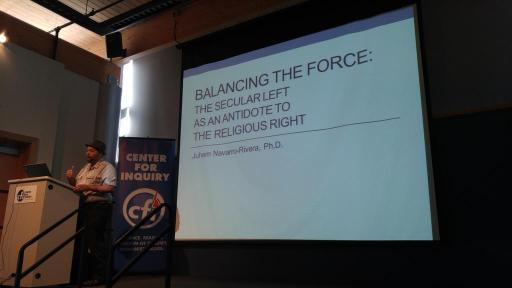I was in Buffalo over the weekend. Not really in Buffalo exactly but in Amherst, NY at the Center for Inquiry’s global domination headquarters. I was a featured speaker at CFI’s annual leadership conference. This year’s theme “Moving Freethought Forward” clearly aligned with my current research interests in race and politics among secular Americans.
I arrived in Buffalo on Friday morning after being stranded for a while on Thursday night (airport celebrity sightings: Curt Schilling and Sen. Elizabeth Warren). After a brief check-in at the hotel and working a little on the first of my two presentations, I went to the CFI headquarters and was able to catch some of the morning sessions. The speakers in those sessions were some of the student participants discussing how their own college (or high school groups) organize and conduct events. The CFI staff also presented about some of their projects.
Watching those presentations gave me an idea of who most of my audience was (the other audience members were leaders of CFI branches, who at the time attended a different event). My first presentation was on the increasing diversity of secular Americans. While initially I focused on race, building on my presentation at the American Humanist Association conference in May, I shifted gears a bit and also discussed sex and gender identity. The movement, or at least the greater secular community, is not just a collection of old white males. Using data from my previous employers, the Institute for the Study of Secularism in Society and Culture (ISSSC) and Public Religion Research Institute (PRRI), I showed that the percentage of people of color and women have increased over time among the “nones.” I also included data on LGBT Americans that shows high levels of secularism among this population.

After the statistical part of the presentation I discussed why these groups are increasingly secular. While education is part of the explanation, I moved away from the usual STEM explanation: that as people learn about science they become more secular. Instead I argued that questioning the power structures in society can be a path to secularism. The picture on the left shows the slide where I placed two secular thinkers of color: James Baldwin and Nemesio Canales. Their secularism wasn’t the kind that refutes religion with science but the one that questions divine authority in light of very inefficient results.
I finished the presentation with a segway to my next presentation. In a slide showing different political leaders of different religions I made the argument that the politics of religious groups in America vary by race: white and black Protestants vote differently, as do white and Latino Catholics. But this is not the case with the Nones.

My second presentation compared a bit the secular left and religious right. They are mirror images of each other, with the exception that the latter is a major force in American conservatism, and the former a bunch of people who tend to agree on political and social issues. My goal was to show that regardless of nomenclature (nones, atheists, agnostics), secular Americans largely agree on the issues that are important today. Moreover, they also have similar levels of political party affiliation, and have been abandoning the GOP in the last quarter-century.
I liked how my presentations were received. Several students and leaders talked to me about what they liked and to continue a bit the conversation. Overall, it was a great conference. The diverse faces in the crowd: young men and women reflective of America’s diverse population give me hope about the future of the movement. Of course, the conference was not possible without the hard work of the CFI crew. I was finally able to meet Debbie Goddard in person and chat again with Paul Fidalgo. I also met Sarah Kaiser, Stef McGraw, and Cody Hashman, who made my life easier handling logistics and tech. And I had the opportunity to meet some amazing fellow presenters: Columbia’s Melanie Brewster, a rising star in the secular scholarly community; Desiree Schell is the person who can put in practice whatever theory of politics I come up with; Keith Lowell Jensen made my face hurt with his jokes, especially those about Max, his 5-year old tweeting daughter; and is always good to see James Croft, one of the most engaging speakers around and whose presentation was, luckily, after mine. I also want to thank Matt Enloe for tweeting a storm, the pictures in this post come from his account.
